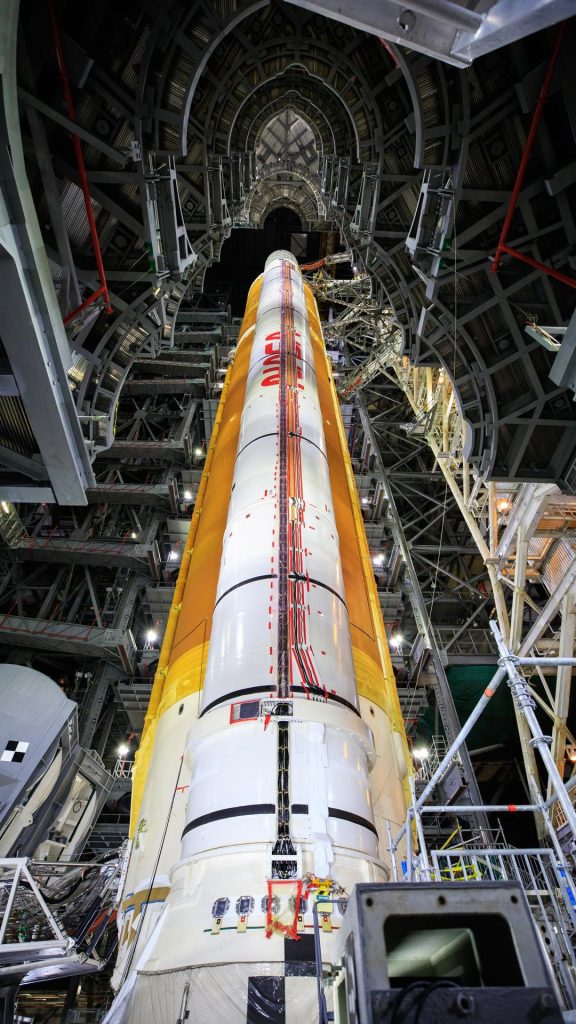
Inside High Bay 3 of the Vehicle Assembly Building at NASA’s Kennedy Space Center in Florida, the work platforms have been retracted from around the Artemis I Space Launch System. Credit: NASA/Frank Michaux
An update on our Artemis I mission, test firing an Artemis rocket engine, and a resupply mission delivers to the space station … a few of the stories to tell you about – This Week at NASA!
Video Transcript:
An update on our Artemis I mission …
Test firing an Artemis rocket engine …
And a resupply mission delivers to the space station …
A few of the stories to tell you about – This Week at NASA!
Teams at our Kennedy Space Center in Florida are assessing schedules and continuing preparations with our Space Launch System or SLS rocket and Orion spacecraft, ahead of the upcoming uncrewed Artemis I mission around the Moon.
We are currently targeting no earlier than March 17 for rollout of the combined spacecraft to Launch Pad 39B for final testing – including the wet dress rehearsal test, which is now targeted for early April.
Launch of Artemis I is still being targeted for the early May timeframe, but activities with other scheduled launches at Kennedy could require mission managers to reevaluate that timeframe.
Learn more about the Artemis I mission at: nasa.gov/artemis-1
Engineers at our Stennis Space Center conducted an RS-25 engine hot fire test on February 24.
Four RS-25s will help power our Space Launch System rocket on future Artemis deep-space missions, including this year’s uncrewed Artemis I mission around the Moon.
This was the fourth overall test in the current test series which began in mid-December.
On February 21, Northrop Grumman’s Cygnus spacecraft arrived at the International Space Station two days after launching from our Wallops Flight Facility in Virginia.
NASA astronauts Raja Chari and Kayla Barron teamed up to capture the Cygnus, which was loaded with about 8,300 pounds of cargo, including important research and critical hardware.
This is also the first Cygnus mission to feature enhanced capabilities of the spacecraft that allow it to use its engines to perform a reboost of the station as a standard service for NASA. A reboost is used to adjust the station’s orbit.
NASA and partner agency NOAA are targeting March 1 for the launch of NOAA’s GOES-T satellite from Cape Canaveral Space Force Station in Florida. GOES-T is the third weather observing and environmental monitoring system satellite in the GOES-R series.
GOES-T will be renamed GOES-18 once it reaches geostationary orbit. Then, after successfully completing an orbital checkout of its instruments and systems, it will go into operational service as GOES West – providing critical data for the U.S. West Coast, Alaska, Hawaii, Mexico, Central America, and the Pacific Ocean.
February 20 was the 60th anniversary of the Mercury-Atlas 6 mission during which late astronaut John Glenn became the first American to orbit Earth.
Glenn’s three-orbit flight aboard the Friendship 7 spacecraft lasted nearly 5 hours – ending with a splashdown landing near the Turks and Caicos Islands, about 800 miles southeast of Cape Canaveral.
He was celebrated as a hero across America and went on to serve several terms as a U.S. senator representing Ohio.
Then in 1998, when he was 77, he returned to space aboard space shuttle Discovery to participate in a series of tests on the aging process.
Glenn passed away in December 2016 at the age of 95.
That’s what’s up this week @NASA.
Science - Latest - Google News
February 27, 2022 at 11:37PM
https://ift.tt/KgJibGO
NASA Updates on Artemis I Mission, Test Fires RS-25 Rocket Engine [Video] - SciTechDaily
Science - Latest - Google News
https://ift.tt/RfeHt4d
https://ift.tt/IKeGiR5
Bagikan Berita Ini

















0 Response to "NASA Updates on Artemis I Mission, Test Fires RS-25 Rocket Engine [Video] - SciTechDaily"
Post a Comment